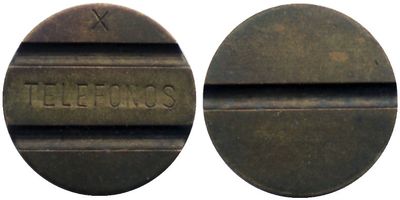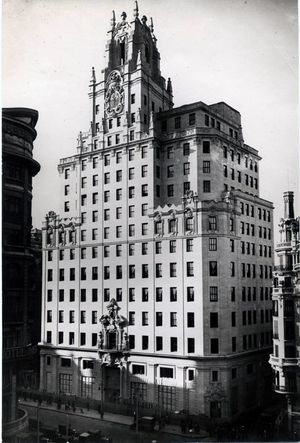Iberian telephone tokens
Spain
In 1924, Compañía Telefónica Nacional de España (CTNE) was established with US telecommunications company ITT as a major shareholder. Photo: first headquarters on Gran Vía in Madrid, 1929; source: Telefónica. In 1945, the Spanish state acquired a share of 79.6% of the company. In 1960, CTNE became the largest enterprise in Spain. A private capital increase in 1967 financed Telefónica's satellite communications. In 1987, Telefónica was listed on the New York Stock Exchange. Nevertheless, Telefónica remained the only telephone operator in Spain.
After a series of investments in Latin America and the launch of a mobile telephone company (Movistar) in 1994, the company was privatised in the period 1995-1999. Yet, Telefónica continues to hold a dominant position in the Spanish market. Due to aggressive foreign investments, it is one of the largest telecommunications companies in the world.
Refs. G = Groenendijk, Henk A.: A Catalog of Telephone and Telegraph Tokens of the World. Leiden 1989.
| Spanish Telephone Tokens | ||
|---|---|---|

| ||
| Material | Brass | |
| Filename | TSP.01.jpg | |
| Side 1 | TELEFONOS under groove, B above | |
| Side 2 | Groove | |
| Size (mm) | 21 | |
| Weight (grams) | 4.05 | |
| Notes | ||

| ||
| Material | Brass | |
| Filename | TSP.09.jpg | |
| Side 1 | B, arrow and TELEFONOS above groove | |
| Side 2 | B, arrow and CTNE above groove | |
| Size (mm) | 21 | |
| Weight (grams) | 4.05 | |
| Notes | ||
| File:TSP.10.jpg | ||
| Material | Brass | |
| Filename | TSP.10.jpg | |
| Side 1 | C, arrow and TELEFONOS above groove | |
| Side 2 | C, arrow and CTNE above groove | |
| Size (mm) | ||
| Weight (grams) | ||
| Notes | ||

| ||
| Material | Brass clad zinc | |
| Filename | TSP.08.jpg | |
| Side 1 | F, arrow and TELEFONOS above groove | |
| Side 2 | F, arrow and CTNE above groove | |
| Size (mm) | 21 | |
| Weight (grams) | ||
| Notes | ||

| ||
| Material | Brass | |
| Filename | TSP.06.jpg | |
| Side 1 | Arrow and TELÉFONOS between grooves. D above | |
| Side 2 | D, Arrow and CTNE | |
| Size (mm) | 21 | |
| Weight (grams) | 4.25 | |
| Notes | G 5 | |

| ||
| Material | Brass | |
| Filename | TSP.07.jpg | |
| Side 1 | Arrow and TELÉFONOS between grooves. H above | |
| Side 2 | H, arrow and CTNE | |
| Size (mm) | 21 | |
| Weight (grams) | 4.25 | |
| Notes | ||

| ||
| Material | Brass | |
| Filename | TSP.05.jpg | |
| Side 1 | Arrow and TELÉFONOS between grooves. T above | |
| Side 2 | Groove, T above, CTNE below | |
| Size (mm) | 21 | |
| Weight (grams) | 3.80 | |
| Notes | ||

| ||
| Material | Brass | |
| Filename | TSP.04.jpg | |
| Side 1 | Arrow and TELÉFONOS between grooves. T above | |
| Side 2 | Groove | |
| Size (mm) | 21 | |
| Weight (grams) | 3.80 | |
| Notes | G 8 | |

| ||
| Material | Zinc clad iron | |
| Filename | TSP.03.jpg | |
| Side 1 | TELEFONOS between grooves. T above | |
| Side 2 | Groove | |
| Size (mm) | 21 | |
| Weight (grams) | 3.30 | |
| Notes | ||

| ||
| Material | Brass | |
| Filename | TSP.02.jpg | |
| Side 1 | TELEFONOS between grooves. X above | |
| Side 2 | Groove | |
| Size (mm) | 21 | |
| Weight (grams) | 3.75 | |
| Notes | G 9 (there is 2 different font for X, bold or thin) | |
Andorra
The first telegram communicating the country with the outside world was sent in 1892. This was the beginning of the opening of Andorra's communications with the world. Since the first of novembre 1892 when Anna Argelich i Arajol, of Cal Ramon d'Andorra la Vella, the first telegraph operator in the country, printed the first telegram between Andorra and France (destined to Bourg-Madame) it rained a lot.
From that first official connection with the neighboring country, the transformation was unstoppable. With the advent of telephones and the introduction of the first networks (in mid-1904, for example, the decree of creation was signed linking Andorra and Spain) everything went on. The General Council, which was in charge of carrying out the whole process, has already detected, among many other issues, the need for someone to start monitoring the telephone line, understanding that it was a vital piece of equipment. The task was entrusted to Josep Rispal.
The telephones were physically making their way and by the 1950s they had already reached the Pas de la Casa (there was even a need to publish a telephone directory). Only five years later the figures hinted at the scale it would take: eight power plants, about fifteen employees distributed across the country. The public service hours of the telephone booths were extended (from seven in the morning to twelve at night) and some schools began to have devices to make calls ... until 1967 when a giant step was taken : it is agreed to install a telephone in all neighborhoods, farmhouses and detached houses of more than one inhabited house. And only four years later, in view of the fact that the volume of subscribers was multiplying, the Council is asked to extend a thousand more lines to the capital's power station.
But the final leap did not come until the mid-1970s, with the launch of the Andorran Telecommunications Service (STA), which was born as the public entity that will exclusively manage telephone, radio and television services. With a central building in Andorra la Vella, the whole project is beginning to be equipped with professionals and technical equipment to be able to operate in good condition.
Portugal
In 1877, Portugal's first telephone service, between Lisbon and Carcavelos, was opened. In 1887, the Anglo-Portuguese Telephone Co., Ltd. (APT) started operations in Lisbon and Porto. Their service was extended to the rest of the country by Correios, Telefones e Telégrafos (CTT), a public company, from 1905. Due to the revolution of 1910, CTT did not obtain a mandate for international telephone lines. From 1925, Companhia Portuguesa de Rádio Marconi (CPRM) provided international telephone connections. Telephone kiosks were introduced in 1932.
In 1968, the Salazar dictatorship nationalised APT, which became Telefones de Lisboa e Porto (TLP), taking over the telephone responsabilities of CTT. CPRM was nationalised a year later. While Salazar saw telephones as a tool for political control at home and in the colonies, his successor, Caetano, treated it as a tool for economic development.
After the revolution of 1974, the system decayed under successive military governments. This changed radically after Portugal's entry into the European Union in 1986. In 1989, the Basic Telecommunications Act created the possibility of privatisation of the telephone system. This option was realised with the creation of Portugal Telecom (PT), fully owned by the government, in 1994. Between 1994 and 2000, the government sold most of its interest in PT, making it Portugal's largest privately held company. PT has made significant foreign investment, in particular in Brazil. In 2015, PT was acquired by French multinational Altice and changed its name accordingly.





